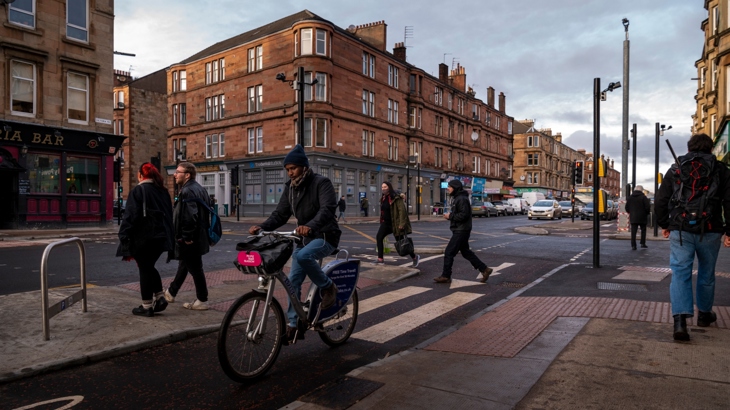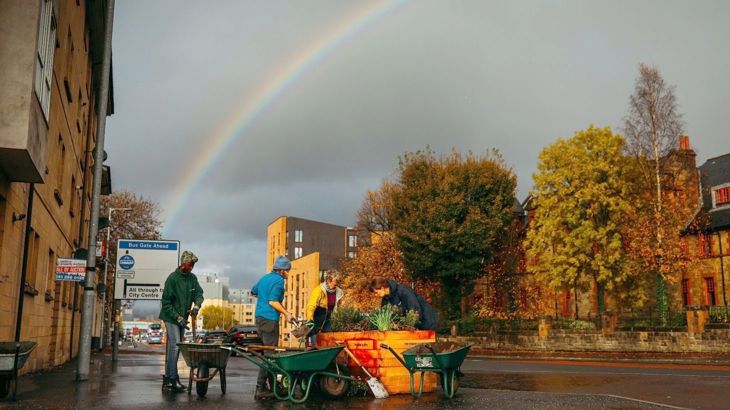From 13 February 2023, the Scottish Government’s new National Planning Framework is at the centre of Scotland’s planning system. Karen McGregor, Scotland Director at Sustrans, talks about what this means for communities across the country.

National Planning Framework 4 will influence all aspects of planning in Scotland, from housing, transport and schools through to businesses and green space. Credit: John Linton, 2021.
Following over 2 years of engagement and development, National Planning Framework 4 (NPF4) was adopted by Scottish Ministers on Monday 13 February 2023.
Scottish Government describe NPF4 as “a long-term plan for Scotland that sets out where development and infrastructure is needed.”
At Sustrans Scotland, we are pleased to see important changes in the final Framework:
- Promoting sustainability, health and inclusion in the planning process
- Scotland-wide action to combat the climate and nature emergencies
- Developing better, liveable neighbourhoods that benefit communities
- Delivering transport links that allow us to leave the car at home more often
- A greener, healthier and more connected approach to transport planning
But what do all of these changes mean for our everyday lives? What sort of impact will they have on the places we live and how we get around?
And, crucially, how do we deliver on the opportunities of National Planning Framework 4 to rebalance Scotland’s places around its people?
What is National Planning Framework 4 and why is it important?
It may sound dramatic, but National Planning Framework 4 sets out a new template for how our communities across Scotland will develop and grow.
It influences all aspects of planning in Scotland, from housing, transport and schools through to businesses and green space.
Planning decisions are taken close to all our communities and they have an impact on us all.
Scotland has 32 local authorities and two national parks that act as planning authorities. Each of these planning authorities can now start preparing local plans that build on the new national framework.
Many of us may not see their impact straight away, but National Planning Framework 4 contains some key changes that will make a big difference to our everyday lives in Scotland.

NPF4 is a response to the climate and nature emergencies and the urgent need to make Scotland’s developments more sustainable to help in the fight against them. Credit: Andy Mccandlish, 2021.
Promoting sustainability, health and inclusion in the planning process
This new National Planning Framework is the fourth of its kind and sets a few firsts.
It is the first to create a ‘spatial strategy.’ This is really important, as the spatial strategy contains guiding principles for good development that now cover the whole of Scotland.
‘Spatial’ refers to the patterns of settlement and the means of connecting them – essentially where people live and how people travel.
These will now be planned in a way that is sustainable and which promotes health and inclusion.
Scotland-wide action to combat the climate and nature emergencies
NPF4 is also the first Framework to create a collection of policies that will apply across the country. This means all the planning authorities mentioned earlier will be aligned in the decisions they are making.
This change has come about in response to the climate and nature emergencies and the urgent need to make Scotland’s developments more sustainable to help in the fight against them.
We all know and appreciate that this will not happen quickly. After all, the Scotland we see around us today is the result of decades, even centuries, of regulated and unregulated development.
But, over time, this important change in approach will improve the way we live and move around.
Developing better, liveable neighbourhoods that benefit communities
We believe better communities are created when directly involving and empowering people from within them.
That’s why we’re really pleased to see liveable places and the ’20-minute neighbourhood’ concept become a central pillar of National Planning Framework 4, alongside a new emphasis on ‘place-making’ and community development.
Giving the people who live there more of a say in how Scotland’s cities, towns and villages develop creates more liveable and inclusive neighbourhoods for everyone, and place-making gives communities and developers the tools they need to plan together.

Creating more cohesive and connected networks of routes, streets and spaces is a crucial step in allowing more people to leave the car at home for more of their journeys. Credit: Jassy Earl, 2020.
Delivering transport links that allow us to leave the car at home more often
Getting more people walking, wheeling and cycling more often has a huge role to play in creating a greener, healthier and fairer Scotland.
Putting active travel first makes a real, positive change in how we see our communities grow, and we’re delighted to see this recognised within NPF4.
Safe and accessible walking, wheeling and cycling links are now the first consideration for connecting any new developments. Active travel connections are now no longer an 'add-on' or 'optional' extra.
National Planning Framework 4 will also improve access to public transport, which will again help to reduce how reliant we are on using cars to make our journeys.
Sustrans now wants to see developers making more contributions towards delivering this positive change and doing their bit to allow more people to choose walking, wheeling and cycling for more everyday journeys.
A greener, healthier and more connected approach to transport planning in Scotland
We believe that transport in Scotland cannot continue to be planned around the car at the expense of its people and communities.
Across the board, we urgently need to take an integrated and people-first approach to planning how we move around.
NPF4 presents a huge opportunity for local authorities to move away from developing isolated ‘bits’ of active travel infrastructure and to take a more rounded and connected approach to improving walking, wheeling and cycling links across their area.
Creating more cohesive, inclusive and connected networks of routes, streets and spaces is a crucial step in allowing more people to leave the car at home for more of their journeys.
We’re urging all of Scotland’s local authorities to act now on this opportunity and give more people in Scotland the chance to make healthier and happier journey choices.
An opportunity to rebalance Scotland around its people
Fundamentally, we need to work together to end the dominance of cars in our public spaces and rebalance our cities, towns and neighbourhoods in favour of the people that live, work and play there.
And we need to create more opportunities for people to make healthier and more sustainable journey choices.
National Planning Framework 4 provides the basis for making these positive changes.
We look forward to continuing to work with all of Scotland’s planning authorities to create more sustainable and better-connected communities which have a positive impact on everyone within them.
Read our response to the Scottish Government’s NPF4 consultation.





